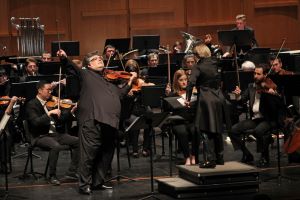On July 22, the nearly weeklong stretch of scorching temperatures and high humidity finally came to an end – unfortunately, just before one of the most highly anticipated concerts of the 2006 Eastern Music Festival. The acclaimed mezzo-soprano Frederica von Stade was scheduled to sing Mahler with the “adult” orchestra and Gerard Schwarz, principal conductor of the festival, was leading a nicely balanced Dana Auditorium program. The sky opened and the lobby became a dangerous minefield of flailing umbrellas, slipping patrons, and some people shivering in the icy air-conditioning in their wet clothes. Well, at least we were not in a tent or an amphitheater!
The evening kicked off in the usual manner that goes back to the beginning of orchestral concerts – with an overture. “The Hebrides” Overture, also known as “Fingal’s Cave,” is one of Mendelssohn’s most beloved and representative compositions. Written in response to the remarkable geographic marvels he encountered on a visit to Scotland, this is an unabashedly programmatic work. He quickly wrote the brooding opening theme, as mere mortals would write a postcard, although the entire work was not to be completed for another sixteen months. Maestro Schwarz galloped out and wasted no time eliciting that opening, as the eight-person cello section delivered a chocolaty, silky start of this musical voyage. Unlike the blindingly sunny “Italian” Symphony and many sections of his Midsummer Night’s Dream, in this work Mendelssohn alternates frenetic high-spirited passages with sublime lyrical sections of wistful beauty. There seemed to be some disjointed handoffs of phrases between sections at first, but the orchestra quickly got their sea legs and delivered a beautiful travelogue of an enchanted land.
Many of us in the biz – either as players, critics, or just plain music lovers – often pride ourselves as completists when it comes to the output of certain composers. When you fall short and experience a “new” work (to your ears) it often feels like the first time you discovered the wonder of great music. For those of us enamored of the music of Gustav Mahler it is relatively easy to collect all of his orchestral output. Much of this contains settings of songs often interchanged within movements of his symphonies in addition to their individual lives. Friedrich Rückert’s poems struck responsive chords in Mahler, who used his writings in the cycle Kindertotenlieder and for the five songs performed on this occasion. These do not have a unifying theme and can effectively be performed as a set or mix-n-match. These were all new to me and it was, not surprisingly, a find as valuable as a beautiful gem.
Von Stade walked out to thunderous applause, looking wonderfully fit and youthful. Just as she began, massive thunderstorms approached the area with ear-splitting percussive effects that rivaled many of the sounds from the stage. Ironically, this served to draw the listener in even more closely to these glorious songs. Each is unique in its orchestration, text and mood – the final song is just woodwinds and brass. The third, “Ich bin der Welt abhanden gekommen” (“I am lost to this world”), is a creation of such depth and beauty, that you feel fortunate to be alive just to hear this music. Von Stade has the perfect voice and presentation for this delicate and introspective poetry. She is free of the maddeningly wide vibrato and incessant swooping into high notes that plague many of her colleagues. Translation was almost unnecessary as the unmistakable Mahler style, combined with von Stade’s expressive delivery, bypassed words and reached directly into your soul.
One of the ways that aspiring composers learned the very complex craft of orchestration was to adapt an existing well-known work (usually written for a keyboard instrument) to the orchestra. Bach’s organ works were a favorite source and enjoyed a great following. Respighi carried this practice well into his later years and in 1930, at the request of Toscanini, orchestrated Bach’s Passacaglia in c minor for a premiere by the New York Philharmonic. This is the type of adaptation that would be the aural equivalent of hell, or at best purgatory, for those musicians who have dedicated their careers to authentic or Historically Informed Practice (HIP) of this music. It is indeed an acquired taste and while I can easily list dozens of much more hellish musical practices, this type of treatment always strikes me as ghoulish and predatory. This bombastic, over-hyped Romantic treatment was quite the rage at that time and there seems to be a comeback of sorts, perhaps in response to the overly self-important and preachy attitudes of many in the HIP community. The Eastern Philharmonic Orchestra played this with skill but with a measured and pedantic approach that robbed it of much of its power.
To go from the previous Bach/Respighi work to the start of his epic suite The Pines of Rome is about as different as you can get. There is no better example of the word “sparkling” as applied to music than the opening measures of this piece. Written in 1924 as part of his lifelong adaptation of music of his beloved city Rome, this may be the first orchestral piece that actually uses a phonograph – for a recording of a nightingale. Harkening back to earlier Italian musical history, Respighi, like Gabrieli in St. Mark’s Cathedral, employs brass sections stationed throughout the concert space, giving a thrilling antiphonal effect. This is an orchestral showpiece that again demonstrated that the Eastern Music Festival’s Eastern Philharmonic is an orchestra that is second-to-none in N.C. and one we are fortunate to experience every summer.











